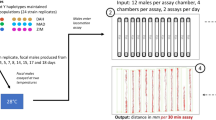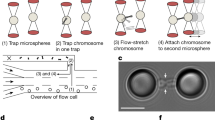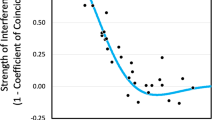Abstract
In natural temperate populations, virgin Drosophila melanogaster females present highly variable periods of preoviposition duration (from 2 to 25 days). Strains were selected for long and short initial retention capacity. Chromosome substitution between two of these lines produced, by appropriate mating procedures, every possible homozygous chromosomal combinations of the X, II and III chromosomes. Analyses of these lines demonstrate that both X and III chromosomes are involved in this egg-laying control, and have complementary effects.
Similar content being viewed by others
Article PDF
References
Albornoz, J, Dominguez, A, Alcorta, E, and Santiago, E. 1987. Chromosomal effects in egg laying of Drosophila melanogaster under different conditions. Heredity, 58, 457–462.
Allemand, R, and David, J R. 1984. Genetic analysis of the circadian oviposition rhythm in Drosophila melanogaster: Effects of drift in laboratory strains. Behav Genet 14, 31–43.
Benzecri, J P. 1973. L'analyse des donnees II L'analyse des correspondances. 619 pp. Dunod Ed. Paris.
Boulétreau-Merle, J. 1975. Influence de l'accouplement sur la physiologie reproductrice des femelles de Drosophila melanogaster (Meig.). Fonctions modifiées, nature des stimulations recues et relais physiologiques mis en jeu. Thése d'Etat, Lyon, 320 pp.
Boulétreau-Merle, J. 1982. Variability of initial retention in natural populations of D. melanogaster. Drosophila Inform Serv, 58, 28–29.
Boulétreau-Merle, J, Allemand, R, Cohet, Y, and David, J. 1982. Reproductive strategy in Drosophila melanogaster: significance of a genetic divergence between temperate and tropical populations. Oecologia (Berl), 53, 323–329.
Boulétreau-Merle, J. 1986. Seasonal genetic variations in fecundity and egg-laying controls in temperate D. melanogaster populations. In Porchet, Andries and Dhainaut (ed.) Adv Invert Reprod 4, 461–470.
Boulétreau-Merle, J, and Terrier, O. 1986. Adaptive diversity in genetic control of egg-laying behaviour in Drosophila melanogaster. Intern J Invert Reprod Develop, 9, 113–124.
Boulétreau-Merle, J, Terrier, O, and Fouillet, P. 1986. Developmental temperature as a selective factor in balancing polymorphisms in D. melanogaster populations. J therm Biol, 11, 143–149.
Chapco, W. 1977. Correlations between chromosome segments and fitness in Drosophila melanogaster. I. The X chromosome and egg production. Genetics, 85, 721–732.
David, J, and Clavel, M F. 1965. Interaction entre le genotype et le milieu d'elevage. Consequences sur les caracteristiques du development de la Drosophile. Bull biol Fr Belg, 94, 369–378.
Dominguez, A, and Rubio, J. 1986. Analysis of genetic factors affecting egg production in Drosophila melanogaster. Heredity, 57, 305–313.
Gauch, H G, Jr. 1982. Multivariate Analysis in Community Ecology. Cambridge University Press, Cambridge, 298 pp.
Hill, M O. 1973. Reciprocal averaging: an eigenvector method of ordination. J Ecol, 61, 237–249.
Kearsey, M J, and Kojima, K. 1967. The genetic architecture of body weight and egg hatchability in Drosophila melanogaster. Genetics, 56, 23–37.
Pyle, D. 1978. A chromosome substitution analysis of geotactic maze behavior in Drosophila melanogaster. Behav Genet, 8, 53–64.
Robertson, F W. 1954. Studies in quantitative inheritance. V. Chromosome analyses of crosses between selected and unselected lines of different body size in Drosophila melanogaster. J Genet, 52, 494–520.
Watanabe, T K, and Ohnishi, S. 1975. Genes affecting productivity in natural populations of Drosophila melanogaster. Genetics, 80, 807–819.
Author information
Authors and Affiliations
Rights and permissions
About this article
Cite this article
Boulétreau-Merle, J., Terrier, O. & Fouillet, P. Chromosomal analysis of initial retention capacity in virgin Drosophila melanogaster females. Heredity 62, 145–151 (1989). https://doi.org/10.1038/hdy.1989.22
Received:
Issue date:
DOI: https://doi.org/10.1038/hdy.1989.22
This article is cited by
-
Cryopreservation method for Drosophila melanogaster embryos
Nature Communications (2021)
-
Absence of clinal variation in virgin retention capacity in Australian Drosophila melanogaster
Evolutionary Ecology (2006)
-
Clinal and seasonal variations in initial retention capacity of virginDrosophila melanogaster females as a strategy for fitness
Evolutionary Ecology (1992)



